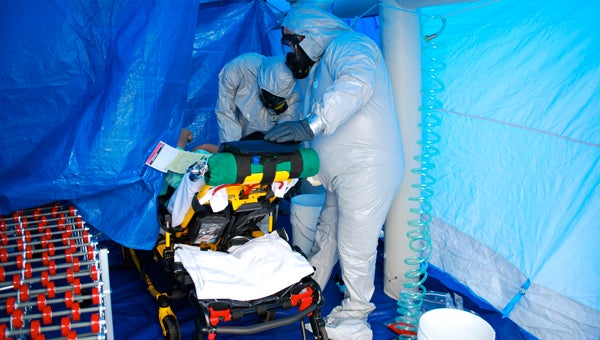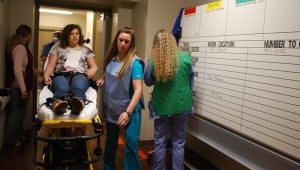Grandview, first responders practice with disaster simulation drill
Published 3:46 pm Thursday, April 14, 2016

Doctors in Hazmat suits examine a patient, played by a Jeff State student, in a decontamination unit during a disaster response drill at Grandview Medical Center on April 14. (Reporter Photo/Molly Davidson)
By MOLLY DAVIDSON / Staff Writer
Doctors outfitted in Hazmat suits and gas masks were positioned outside a decontamination unit at the Grandview Medical Center emergency department, waiting for ambulances to deliver patients from a simulated tanker truck collision in a disaster drill on April 14.
The large-scale drill involved emergency department doctors and nurses along with local first responders from the Birmingham, Rocky Ridge and Cahaba Valley fire departments, and allowed all groups to run through procedure for a disaster with potential mass casualties.
“What we simulated today was an 18-wheeler having a collision with a commuter bus on a major roadway,” Grandview Medical Center ER Director Mike Gaither said.

A decontaminated patient, played by a Jeff State student, is brought into the Grandview emergency room. (Reporter Photo/Molly Davidson)
Fire department responders were first to arrive at the simulated collision scene, in which nearly 30 victims, played by Jefferson State Community College nursing students, were exposed to an unknown chemical released from the truck.
“We’re usually the first on the scene,” Birmingham Fire and Rescue Battalion Chief Gregory Elston said. “When you have a game plan, you need to practice it.”
Fire department responders first had to evaluate the scene, determine the chemical, relay the information to the hospital and do an initial “gross decontamination” of the victims before they were transported by ambulance to the hospital.
The chemical was determined to be gas, and the information was relayed to the staff at Grandview.
“We would then institute our emergency action plan,” Gaither said. “We would make a decision to call disaster mode (into action).”
A full-scale decontamination unit was set up at Grandview Medical Center, ready to admit victims.
Arriving victims were decontaminated a second time in a three-station tent, then they were led into the hospital through a third decontamination room.
“It’s getting them ready for treatment,” Gaither said of the multiple decontaminations.
Once inside the hospital, doctors and nurses quickly evaluated each patient’s injuries and conditions. Patients needing immediate attention, such as those with amputated limbs, were taken into treatment, while less serious injuries were filtered staging areas to await treatment.
Assistant ER Director Marsha Pope recorded each patient’s condition and location on a large whiteboard.
“It’s our command center board… as (patients) arrive, I mark them,” Pope said, explaining the board is arranged so ER staff can quickly determine the condition and location of patients. “You break it down to know what you have.”
Running exercises such as the April 14 drill are important and help first responders, doctors and nurses prepare for even unlikely situations, doctor Casey McIntosh said.
“It’s huge organization,” McIntosh said, noting the many moving parts involved in disaster response. “We’re just practicing for real life events.”









